1,250 years ago today, the first Patriarch of the Shingon Sect—one of the most important in Japanese Buddhism was born. Born Saeki no Mao, but dying Kōbō Daishi, he is known to laymen as Kukai—who first brought Vajrayana Buddhism to Japan after traveling to Tang China. Today, over 5 million Japanese self-identify with the Shingon Sect, second only in number of followers to Nichiren Buddhism among the native Japanese Buddhism schools. READ about his Asia-changing accomplishments… (774)
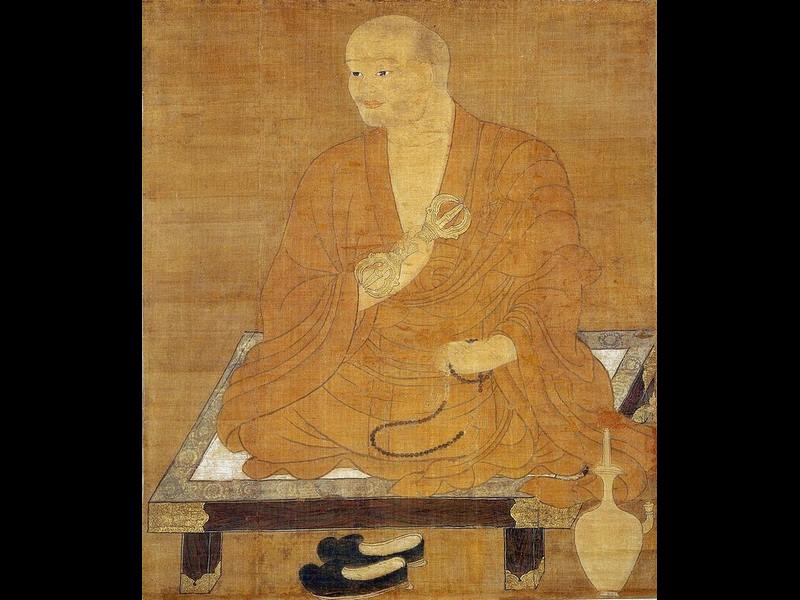 Kukai, the first Patriarch of the Shingon Sect of Japanese Buddhism – CC 4.0. (Integrated Collections Database of the National Museums, Japan)
Kukai, the first Patriarch of the Shingon Sect of Japanese Buddhism – CC 4.0. (Integrated Collections Database of the National Museums, Japan)In 816, Kukai, having already returned an ordained monk from Tang China with teachings and translations of Vajrayana, received patronage from the Japanese emperor to establish a mountain retreat on Mount Kōya. This wasn’t to be finished until after Kukai’s death, but today is one of the central pilgrimage sites of Shingon Buddhism, and is honored as a UNESCO World Heritage Site.
Along with being an expert in the Dharma, Kukai was experienced in public engineering works, aiding in the repair of the Manno Reservoir, and in 823 began construction of two major Shingon temples commissioned by the Emperor Saga, Tō-ji and Sai-ji.
Again he was tasked with organizing construction in 824, this time for the temple he founded called Zenpuku-ji, the second oldest temple of the Edo (Tokyo) region still standing today.
The Shingon school’s teachings and rituals had an influence on other Japanese traditions, especially those of the Tendai school, as well as Shugendo and Shinto. Its teachings also influenced the ritual repertoire of Japanese Zen, including Soto Zen (through the figure of Keizan). Shingon Buddhism also influenced broader Japanese culture, including medieval Japanese aesthetics, art, and craftsmanship.
MORE Good on this Day:
158 years ago, the Transatlantic Telegraph Cable was pulled ashore at Heart’s Content, Newfoundland, having been towed 1,600 miles by Isambard Kingdom Brunel’s steamship. The cable altered for all time personal, commercial, and political relations between people across the Atlantic. Since 1866 there has been a permanent cable connection between the continents.
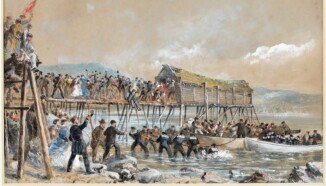 North Atlantic Telegraph Cable – pub domain
North Atlantic Telegraph Cable – pub domainThe first cable across the Atlantic, laid by The Atlantic Telegraph Company led by Cyrus West Field functioned for only 3 weeks before having to be abandoned after an operator overloaded the voltage. A second one was made with much improved materials, but it broke halfway across the Atlantic.
Field was ignorant of submarine telegraph cables when he took up the project and consulted with the world’s leading expert at the time, John Watkins Brett who had organized the laying of telegraph cables across both the English and Irish channels.
The first cable Field commissioned for the project consisted of 7 copper wires, each weighing 26 kg/km, covered with three coats of gutta-percha, weighing 64 kg/km, and wound with tarred hemp, over which a sheath of 18 strands, each of 7 iron wires, was laid in a close helix. It weighed nearly 550 kg/km, was relatively flexible, and could withstand tension of several tens of kilonewtons.
Field had to cross the Atlantic Ocean 56 times in the course of planning the operation. The steamship which took the third and final cable across the ocean was Isambard Brunel’s SS Great Eastern, nothing less than the largest ship ever built at the time of its maiden voyage, powered by twin paddle steamers and sails. (1866)
3 years ago today, the largest repatriation of artifacts in American history, 17,000 in all, was sent from the U.S. State Department back to Baghdad. It was a collection of confiscated contraband, as looters continually depleted the country’s heritage over the 20-year American occupation. Iraq of course is the site of many of the civilizations of ancient Mesopotamia, much of the collection is 3,500 – 4,000 years old.
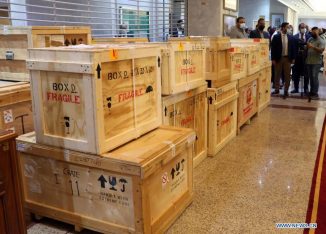 – Xinhua
– XinhuaChief among the artifacts is a section of the famous poem the Epic of Gilgamesh, known as the Gilgamesh Dream Tablet. This was smuggled into the U.S. by an antiquities dealer and sold at Christie’s auction house for $1.4 million to the U.S. craft chain Hobby Lobby, who later supported the order by a federal court of New York to return to priceless cuneiform tablet to Iraq. (2021)
On this day 103 years ago, a Canadian surgeon and a medical student successfully isolated the hormone insulin for the first time.
A University of Toronto orthopedic surgeon, Dr. Frederick Banting, recruited the chemistry skills of an assistant, Charles Best, to help with isolating the insulin, which then produced normal blood glucose levels when injected.
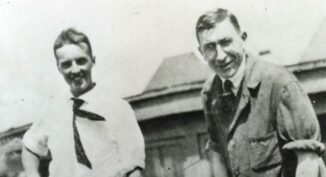 Photo of Banting and Best, 1921– Expired Copyright: Library and Archives Canada / C-001350
Photo of Banting and Best, 1921– Expired Copyright: Library and Archives Canada / C-001350Before the breakthrough, people with type 1 diabetes rarely lived more than a year or two. One of the 20th century’s greatest medical discoveries, it still remains the only effective treatment for type 1 diabetes.
By 1923, insulin had become widely available in mass production, and Banting was awarded the Nobel Prize in medicine. Charles Best, being a graduate student, was not included, but Banting recognized him by sharing the award money.
Banting and his colleague John Macleod, who shared the Noble honor, were reluctant to patent their insulin process on grounds of medical ethics. But they did secure a patent, only to prevent any pharmaceutical company from gaining a monopoly, and they published their research so anyone could use it. (1921)
And, on this day in 1992, Nelson Mandela announced a general strike to demand free elections and the removal of South African President F. W. de Klerk, with whom he would later share a Nobel Peace Prize.
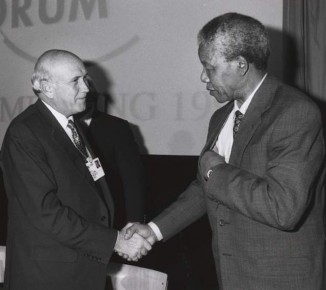 1992 World Economic Forum, CC
1992 World Economic Forum, CCThe successful strike was called two years after he was freed from decades in prison and became the president of his recently legalized political party, the African National Congress. Many books and movies have been produced about the reconciliation between these two men.
84 years ago today, Bugs Bunny, the wisecracking Warner Bros cartoon character, first debuted in an animated short entitled A Wild Hare.
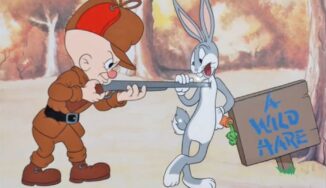
Supervised by Fred ‘Tex’ Avery, it featured a hunter named Elmer Fudd pursuing a wily rabbit voiced by Mel Blanc. The pair became beloved, and their debut received an Oscar nomination for Best Animated Short.
The cartoon opens with Elmer tiptoeing as he tells the audience, “Shh. Be vewy, vewy quiet; I’m hunting wabbits.” Elmer then tries to lure Bugs out of his hole with a carrot, while hiding behind a tree. Bugs’ arm reaches out of the hole, feels around, and snatches the carrot, but soon sees Elmer’s double-barreled shotgun. It quickly gets bent into a bow before Bugs shows up later, saying while eating another carrot, “What’s up, Doc?”, which reportedly brought down the house in every movie theater—and became his signature line.
Learn more about the making of the characters in a video from the History Pod. WATCH the opening and closing scenes… (1940)
SHARE the Milestones, Memories, and Music…
Source link

